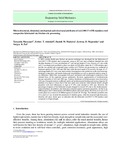Please use this identifier to cite or link to this item:
https://cris.library.msu.ac.zw//handle/11408/4613Full metadata record
| DC Field | Value | Language |
|---|---|---|
| dc.contributor.author | Marazani, Tawanda | - |
| dc.contributor.author | Akinlabi, Esther. T. | - |
| dc.contributor.author | Madyira, Daniel. M. | - |
| dc.contributor.author | Majumdar, Jyotsna. D. | - |
| dc.contributor.author | Pal, Surjya. K. | - |
| dc.date.accessioned | 2021-11-25T13:51:46Z | - |
| dc.date.available | 2021-11-25T13:51:46Z | - |
| dc.date.issued | 2021 | - |
| dc.identifier.issn | 2291-8752 | - |
| dc.identifier.issn | 2291-8744 | - |
| dc.identifier.uri | http://growingscience.com/beta/esm/4999-microstructural-elemental-mechanical-and-structural-attributes-of-aa1100-17-4-ph-stainless-steel-composites-fabricated-via-friction-stir-processing.html | - |
| dc.identifier.uri | http://hdl.handle.net/11408/4613 | - |
| dc.description.abstract | A 100% overlap double pass friction stir process technique was developed for the fabrication of AA1100/17-4 PH stainless steel composites, using an H13 tool steel cylindrical threaded pin with shoulder diameter of 21 mm, pin diameter of 7 mm and pin height of 5 mm. Grooves of 2 mm width and 3.5 mm depth were machined on the 6 mm thick AA1100 plate, where the 17-4 PH stainless steel powder was packed and compacted using a pinless tool. Friction stir processing was conducted at rotational speeds of 2100, 2450 and 2800 rpm, while the travel speed of 20 mm/min, tilt angle of 2.5° and plunge depth of 0.2 mm, were kept constant. Investigations were carried out on the microstructure, elemental composition, and tensile testing and microhardness as well as structural analysis using X-ray diffraction. Defect-free micrographs with good mechanical and metallurgical connections were obtained from all the employed process parameters. However, agglomeration of reinforcements became noticeable at 2450 and 2800 rpm. Uniform distribution of reinforcements were observed at 2100 rpm. Elemental analysis confirmed matrix and reinforcements blending and mixing. Superior SZ hardness of as high as 4 times that of the base metal were achieved, while ultimate tensile strength properties with joint efficiencies as high as 97.29% were attained at 2450 rpm. However, the percentage elongation of the fabricated samples dropped by around 10% due to the reinforcements-induced hardness. Nonetheless, the fabrications retained superior mechanical properties. All the X-ray diffractograms had 5 intense peaks with different phases and crystal planes. However, an Al syn (111) crystal plane was common to all diffractograms at around 39° 2θ range. The obtained crystallite sizes of as small as 4 nm revealed the attainment of ultrafine grains, while the observed high dislocation densities and micro strains gave an indication that the fabricated AA1100/17-4 PH stainless steel composite is of high strength. | en_US |
| dc.language.iso | en | en_US |
| dc.publisher | Growing Science | en_US |
| dc.relation.ispartofseries | Engineering Solid Mechanics;Vol. 9; No. 4: p. 391-414 | - |
| dc.subject | Stainless steel composites | en_US |
| dc.subject | Friction stir processing | en_US |
| dc.subject | Microstructural | en_US |
| dc.subject | Structural | en_US |
| dc.title | Microstructural, elemental, mechanical and structural attributes of AA1100/17-4 PH stainless steel composites fabricated via friction stir processing | en_US |
| dc.type | Article | en_US |
| item.openairecristype | http://purl.org/coar/resource_type/c_18cf | - |
| item.languageiso639-1 | en | - |
| item.cerifentitytype | Publications | - |
| item.fulltext | With Fulltext | - |
| item.grantfulltext | open | - |
| item.openairetype | Article | - |
| Appears in Collections: | Research Papers | |
Files in This Item:
| File | Description | Size | Format | |
|---|---|---|---|---|
| Microsoft Word - esm_2021_17.pdf | Abstract | 229.52 kB | Adobe PDF |  View/Open |
Page view(s)
196
checked on Dec 17, 2025
Download(s)
40
checked on Dec 17, 2025
Google ScholarTM
Check
Items in MSUIR are protected by copyright, with all rights reserved, unless otherwise indicated.



